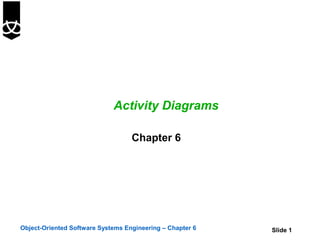
6. activity diagrams
- 1. Activity Diagrams Chapter 6 Object-Oriented Software Systems Engineering – Chapter 6 Slide 1
- 2. Objectives In this chapter we will: Introduce Activity Diagrams Discuss where activity diagrams are used Object-Oriented Software Systems Engineering – Chapter 6 Slide 2
- 3. Activity Diagrams Use activity diagrams in the context of system as whole a subsystem an operation Model dynamic aspect of a system in two ways a workflow -- to visualise , specify, construct, and document business processes an operation -- to model the details of a computation involved with parameters of the operations and its local objects Object-Oriented Software Systems Engineering – Chapter 6 Slide 3
- 4. Activity Diagrams Activity a sort of state which is left by the previous activity activity can involve many steps, including waiting for events Transition an arrow line without label actions are included in activities rather than on the transition Synchronisation bar describing the co-ordination of activities waiting for all the subtasks to finish before proceeding (join), starting several subtasks in parallel (fork) Object-Oriented Software Systems Engineering – Chapter 6 Slide 4
- 5. Activity Diagrams Decision activity an alternative to guard conditions on separate transitions leaving the same state Swimlanes and partitions several groups of related activities these activities are related according to which objects or actors perform them Start and stop Object-Oriented Software Systems Engineering – Chapter 6 Slide 5
- 6. Activity Diagrams Decision activity Activity 1 Activity 2 [condition 1] start [condition 2] Activity 3 Activity 4 Activity 5 Synchronisation bar stop Object-Oriented Software Systems Engineering – Chapter 6 Slide 6
- 7. Activity Diagrams - modelling workflow Establish a focus for the workflow to show all interesting activities in one diagram Select the business objects that have high-level responsibility for the parts of the overall workflow, and each important business object is associated with a swimlane Identify the pre-conditions and post-conditions of the workflow Specify the activities and actions that take place over time Object-Oriented Software Systems Engineering – Chapter 6 Slide 7
- 8. Activity Diagrams - modelling workflow Provide a separate activity diagram to expand complicated actions or set of actions Consider branching activities with forking and joining There are more advanced features Object-Oriented Software Systems Engineering – Chapter 6 Slide 8
- 9. Activity Diagrams - modelling an operation Collect the abstractions that are involved in the operation (parameters, return type, attributes) Identify pre & post conditions & any invariants Beginning at the operations initial state, specify the activity & actions that take place over time & render them in an activity diagram as either activity states or action states Use branching as necessary to specify conditional paths and iteration Use forking and joining as necessary to specify parallel flows of control Object-Oriented Software Systems Engineering – Chapter 6 Slide 9
- 10. Activity Diagrams - Example [joined bank] log on second level authorisation make manage payment instruction Object-Oriented Software Systems Engineering – Chapter 6 Slide 10
- 11. Library Users Librarian Activity diagrams [borrow] Find book Example on shelf [return] Wait in queue [returning] [borrowing] Record Put book return back on shelf Spot the mistakes! Record borrowing Prepare for next user Object-Oriented Software Systems Engineering – Chapter 6 Slide 11
- 12. Customer Sales Warehouse Request product Process order Pull materials Ship order Receive order Bill customer Pay bill Activity diagrams Close order - Example Object-Oriented Software Systems Engineering – Chapter 6 Slide 12
- 13. Activity diagrams - Example 4 [grade >= 40] print “Failed” [false] [true] print “Passed” Object-Oriented Software Systems Engineering – Chapter 6 Slide 13
- 14. Activity Diagrams - Example [grade >= 40] print “Failed” [false] [true] print “Passed” Object-Oriented Software Systems Engineering – Chapter 6 Slide 14
- 15. More About Activity Diagrams Suitable for: Analysing a use case Understand what actions need to take place Describe the behavioural dependencies between objects Allocate operations to objects within interactive diagrams Understanding workflow across many cases Representing use cases interacting with each other Dealing with multithreaded applications Not suitable for: Trying to see how objects collaborate – use collaboration diagrams instead Trying to see how an object behaves over its lifetime – use state diagrams instead Object-Oriented Software Systems Engineering – Chapter 6 Slide 15
- 16. Summary In this chapter we have: Introduced Activity Diagrams Discussed where activity diagrams are used Object-Oriented Software Systems Engineering – Chapter 6 Slide 16
Notas del editor
- 1
